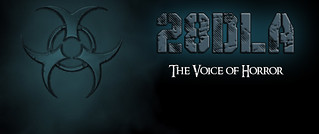*full disclosure: an online screener of this film was provided by an anonymous source.
Director: Jacob Gentry.
Writers: Jacob Gentry and Alex Orr.
Cast: Chad McKnight, Brianne Davis, AJ Bowen and Michael Ironside.
Jacob Gentry is best known to this reviewer for his work on The Signal (2007). Also very dark in lighting and setting, Synchronicity is a sci-fi thriller with heart. Unfortunately for Jim (Chad McKnight), his heart has been besmitten by a femme fatale, straight out of a noir film. But, this is neo-noir in which a financial oligarch rules the world and greed matters. Jim's time travelling experiments are a means to an ends for Klais Meisner (Michael Ironside). But, they also allow Jim to pursue Abby (Brianne Davis) - the femme fatale, across time periods and across dimensions. Heavily influenced by Ridley Scott's Blade Runner (1982), in lighting, setting and music, Synchronicity has something to say about our limited time, in this mortal coil.
The film begins with Jim in his lab. He works with two other scientists to open a worm hole. The premise sounds ridiculous: "opening a wormhole in the space time continuum." But, it is all said with a straight face and something comes out of all this seriousness, another Jim. This time, Jim comes from the future to warn his past self, of Abby. She will break his heart and steal his time machine plans. The character Klaus Meisner, played by a sneering Michael Ironside, just wants to own it all, even Abby and Jim. The end result is an overlapping timeline.
The film's style is heavily influenced by film noir, or more specifically neo-noir. Noir has been a popular style of shooting predominantly since the '40s. In these films, detectives hunt down missing people, while succumbing to scheming vixens. Rooms are smoky and dark and there is always time for a chase sequence. In neo-noir, themes of consumerism or materialism are often present. Within Synchronicity, Meisner's greed looks ready to upset Jim's experiments. Greed is only prevalent through the first half of the film, though; Meisner strangely disappears during the second half. Still, Abby plays the femme fatale with some similarities to Blade Runner's Rachael (Sean Young). Both characters are always hidden behind a fog of cigarette smoke and so are their motivations. Meanwhile, the film landscape is often dark and artificial. There is barely a shot of a natural landscape, or even of the sky. Everything is dark and moody, appropriate to neo-noir stylings.
The film borrows much of its visual style from the aforementioned Blade Runner. The strobe lighting, synthesizer infused music and dark settings have all been lifted from this early 1982 film. Strobe lights peek through blinds in both films as if an ever present eye is watching everything. The soundtrack is futuristic and created by a computer. The synth' sounds stream through the speakers as if a spaceship was just passing by. As well, all of the settings look to be from the future. Elevators shuttle people about an austere landscape, devoid of life. Skylines look dark and bleak. The future looks to be full of dread and darkness. Barely any light can shine for very long. A true homage to this earlier work, Synchronicity suffers from a minor drawback. Whereas in Blade Runner, the film's core theme, artificial intelligence becoming sentient, is enhanced by the artificial looking settings. Synchronicity's story is more natural and focused on the romantic natures of Abby and Jim. Love would surely have difficulty flowering in all of the film's dark, harsh exteriors.
Viewers might notice a central theme developing with a second watching of the film; our time is limited and precious. Possibly, one of the drawbacks of being human and possibly the source of some of our suffering is knowing of our mortality, our limited time on this Earth. The film introduces this theme mostly through Jim's dialogue. Early in the film, he says to Abby: "time is our only currency." It runs out over time and is of extreme value. Jim is consistently worrying about running out of time as he fights the dire effects of time-shifting and dimension travel. The film ends with another important quote "time is a great teacher that eventually kills all of its students." This quote practically ends the film and its timing is important. The writing team of Jacob Gentry and Alex Orr want to leave the viewer with the thought that time is important and precious and running out. Jim spends most of his time chasing the mysterious and alluring girl. How will you spend yours?
Synchronicity has recently played at the Fantasia International Film Festival in Montreal. This film critic expects that the film will continue to play through film festivals; though, this is difficult to confirm. Very little official news on the film is available and fans of sci-fi, or of impacting indie pictures will have to actively seek out future showing dates. If you can find the film, you will be rewarded with a complex story, set in a neo-noir, almost black world. Here, everyone has their secrets and dark motivations.
Overall: 8 out of 10.
For those feeling nostalgic as this viewer did while watching Synchronicity, Vangelis' original Blade Runner score can be found below. This soundtrack is one of the most distinct and therefore most recognizable film compositions in film history:
Vangelis' Original Blade Runner Score
Recommended release: Blade Runner at Amazon
Subscribe to 28 Days Later: An Analysis 28 Days Later Analysis Email Subscription
Director: Jacob Gentry.
Writers: Jacob Gentry and Alex Orr.
Cast: Chad McKnight, Brianne Davis, AJ Bowen and Michael Ironside.
Jacob Gentry is best known to this reviewer for his work on The Signal (2007). Also very dark in lighting and setting, Synchronicity is a sci-fi thriller with heart. Unfortunately for Jim (Chad McKnight), his heart has been besmitten by a femme fatale, straight out of a noir film. But, this is neo-noir in which a financial oligarch rules the world and greed matters. Jim's time travelling experiments are a means to an ends for Klais Meisner (Michael Ironside). But, they also allow Jim to pursue Abby (Brianne Davis) - the femme fatale, across time periods and across dimensions. Heavily influenced by Ridley Scott's Blade Runner (1982), in lighting, setting and music, Synchronicity has something to say about our limited time, in this mortal coil.
The film begins with Jim in his lab. He works with two other scientists to open a worm hole. The premise sounds ridiculous: "opening a wormhole in the space time continuum." But, it is all said with a straight face and something comes out of all this seriousness, another Jim. This time, Jim comes from the future to warn his past self, of Abby. She will break his heart and steal his time machine plans. The character Klaus Meisner, played by a sneering Michael Ironside, just wants to own it all, even Abby and Jim. The end result is an overlapping timeline.
The film's style is heavily influenced by film noir, or more specifically neo-noir. Noir has been a popular style of shooting predominantly since the '40s. In these films, detectives hunt down missing people, while succumbing to scheming vixens. Rooms are smoky and dark and there is always time for a chase sequence. In neo-noir, themes of consumerism or materialism are often present. Within Synchronicity, Meisner's greed looks ready to upset Jim's experiments. Greed is only prevalent through the first half of the film, though; Meisner strangely disappears during the second half. Still, Abby plays the femme fatale with some similarities to Blade Runner's Rachael (Sean Young). Both characters are always hidden behind a fog of cigarette smoke and so are their motivations. Meanwhile, the film landscape is often dark and artificial. There is barely a shot of a natural landscape, or even of the sky. Everything is dark and moody, appropriate to neo-noir stylings.
The film borrows much of its visual style from the aforementioned Blade Runner. The strobe lighting, synthesizer infused music and dark settings have all been lifted from this early 1982 film. Strobe lights peek through blinds in both films as if an ever present eye is watching everything. The soundtrack is futuristic and created by a computer. The synth' sounds stream through the speakers as if a spaceship was just passing by. As well, all of the settings look to be from the future. Elevators shuttle people about an austere landscape, devoid of life. Skylines look dark and bleak. The future looks to be full of dread and darkness. Barely any light can shine for very long. A true homage to this earlier work, Synchronicity suffers from a minor drawback. Whereas in Blade Runner, the film's core theme, artificial intelligence becoming sentient, is enhanced by the artificial looking settings. Synchronicity's story is more natural and focused on the romantic natures of Abby and Jim. Love would surely have difficulty flowering in all of the film's dark, harsh exteriors.
Viewers might notice a central theme developing with a second watching of the film; our time is limited and precious. Possibly, one of the drawbacks of being human and possibly the source of some of our suffering is knowing of our mortality, our limited time on this Earth. The film introduces this theme mostly through Jim's dialogue. Early in the film, he says to Abby: "time is our only currency." It runs out over time and is of extreme value. Jim is consistently worrying about running out of time as he fights the dire effects of time-shifting and dimension travel. The film ends with another important quote "time is a great teacher that eventually kills all of its students." This quote practically ends the film and its timing is important. The writing team of Jacob Gentry and Alex Orr want to leave the viewer with the thought that time is important and precious and running out. Jim spends most of his time chasing the mysterious and alluring girl. How will you spend yours?
Synchronicity has recently played at the Fantasia International Film Festival in Montreal. This film critic expects that the film will continue to play through film festivals; though, this is difficult to confirm. Very little official news on the film is available and fans of sci-fi, or of impacting indie pictures will have to actively seek out future showing dates. If you can find the film, you will be rewarded with a complex story, set in a neo-noir, almost black world. Here, everyone has their secrets and dark motivations.
Overall: 8 out of 10.
For those feeling nostalgic as this viewer did while watching Synchronicity, Vangelis' original Blade Runner score can be found below. This soundtrack is one of the most distinct and therefore most recognizable film compositions in film history:
Vangelis' Original Blade Runner Score
Recommended release: Blade Runner at Amazon
Subscribe to 28 Days Later: An Analysis 28 Days Later Analysis Email Subscription


 Saturday, October 24, 2015
Saturday, October 24, 2015
 Michael Allen
Michael Allen





 Posted in:
Posted in: 


0 comments:
Post a Comment